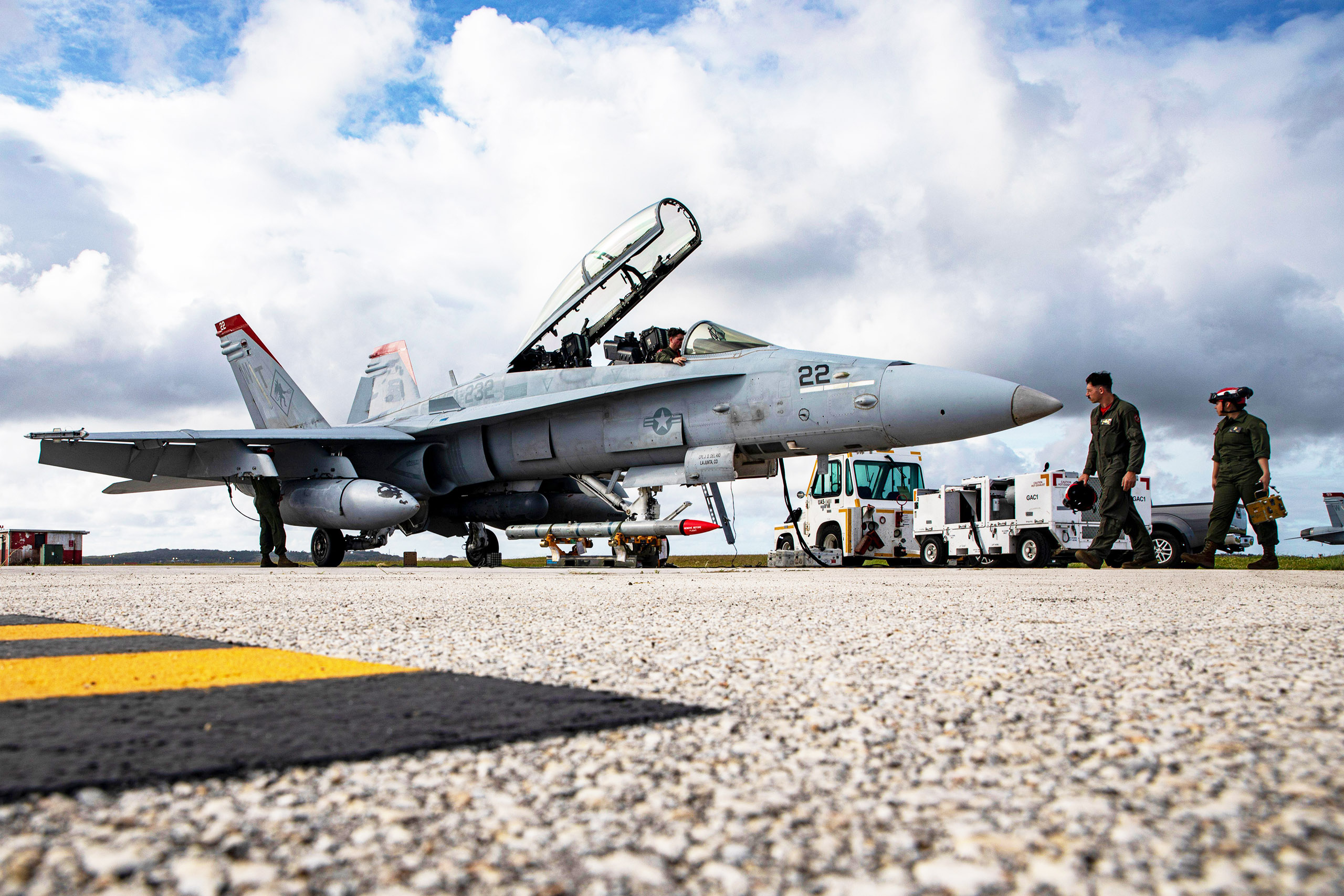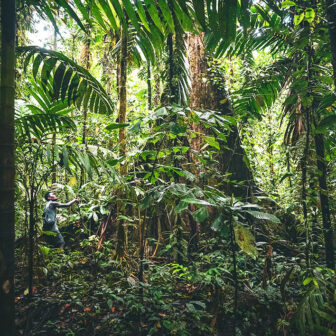Robert Underwood is worried about the direction of American policy in the northern Pacific. The former representative of Guam in the US Congress sees the strategic competition between the United States and China posing an important question for all Pacific Islanders: “Do you want to be pawns in a chess game in which large countries are actually making the decisions?”
The territory of Guam — known as Guåhan to the indigenous CHamoru people — has been administered by the United States since the late nineteenth century. Today, as strategic competition with China intensifies across the region, the Pentagon has announced a new Guam-based military taskforce to coordinate defence operations in the northern Pacific.
Beyond Guam, the United States has extensive security programs in most Micronesian countries and territories. Last year, when Washington renegotiated its Compacts of Free Association with the Marshall Islands, Palau and the Federated States of Micronesia, or FSM, it extended unprecedented power over defence, security and foreign policy on top of existing development funding and migration access for Micronesians to the United States. As chief US negotiator Joseph Yun put it, “The most important thing we get out of them is, of course, access to their land, their air, and their water. It’s crucially important.”
Washington’s aim is to maintain a policy of “strategic denial” against China across Guam, the three Compact states and the Commonwealth of the Northern Marianas Islands, or CNMI. But its influence is being undermined by a dysfunctional US Congress and renewed regional engagement by China, Australia, Japan and other countries.
Micronesian leaders fear that strategic competition with China is driving Washington’s priorities, diverting much-needed resources to the military rather than social infrastructure, ocean management and climate change. Recently, for example, US congressional approval of vital Compact funding promised by the Biden administration was delayed for six months. “At some point,” said Marshall Islands president Hilda Heine, “our nation to needs seriously consider other options available to us if the US is unable or unwilling to keep its commitments to us. Our nation has been a steadfast ally of the United States, but that should not be taken for granted.”
Underwood, who sat in Congress in Washington but had no vote, also sees the Chinese threat as “the main motivator for changing the nature of the negotiations. How the Pacific fits into this discussion is what drives Washington. It certainly isn’t a basic concern over the Pacific islands. Prior to Chinese activities, the US interest in the Pacific was lukewarm at best and disinterested at worse.”
As the Pacific Islands Forum’s 2018 Boe Declaration on Regional Security says, “climate change remains the single greatest threat to the livelihoods, security and wellbeing of the peoples of the Pacific.” But the people of Guam must now also live with the threat of state-to-state conflict, says Kenneth Gofigan Kuper, a political scientist at the University of Guam.
“Because of our relationship with United States and our geographic location,” Kuper tells me, “we cannot say that the potential of kinetic military conflict is overstated. It’s easier for other parts of Oceania to say the geopolitics issues are overplayed, but I don’t think we have that luxury.”
To broaden the security debate and highlight the perspectives of affected island communities, Kuper joined Underwood and researcher Leland Bettis to establish the Pacific Center on Island Security. The Guam-based think tank aims to ensure that islanders themselves have a voice “amongst the cacophony that is geopolitical posturing.”
“Island security is very different from using islands for your security,” says Kuper. “We are trying to open up debate about what is considered islands security and believe much of the security conversation should be coming from islanders themselves, without having the terms dictated by Washington DC, by Beijing, by Australia.”
In the stream of material about Indo-Pacific security published by think tanks in the United States and Australia, the voices of Micronesian islanders are rarely highlighted. Kuper argues that the militarisation of Guam and the neighbouring Compact states should be at the centre of analysis.
“Guam can often be seen as a microcosm of the way that US–China relations are going,” he says. “The moves that the United States are making on Guam and how China sees those changes have a lot to say about the trajectory of future conflict. We think that Micronesia will be a centre for geopolitical manoeuvring in this region.”
This geopolitical contest is playing out as China extends diplomatic ties in the region. While Palau and Marshall Islands have ties to Taiwan, FSM maintains diplomatic relations with Beijing. During a delegation to China led by FSM president Wesley Simina last month, Chinese president Xi Jinping announced RMB100 million (A$21 million) for Belt and Road infrastructure in FSM. But Simina has also welcomed US plans to build new military facilities in FSM: “The Federated States of Micronesia is open for US consideration for any kind of defence-related activities, including use of our lands and oceans.”
Across the northern Pacific, the Biden administration is taking up that offer, showering the US military with billions of dollars to use in Hawai’i, Guam and across the Micronesian islands. The Hawai’i-based US Indo-Pacific Command is upgrading naval shipyards, building new airstrips and storage for fuel, munitions and equipment, and deploying B-52 bombers, nuclear submarines and more US Marines to the islands.
As host to key American military installations in the western Pacific, Guam has been dubbed “the tip of the spear” and “the forward edge of the Indo-Pacific.” The US Department of Defence owns a quarter of the island’s land mass; its major facilities there include Andersen Airforce Base at Yigo and Naval Base Guam at Apra Harbour, Santa Rita. Although Guam has a population of just 154,000, it hosts nearly 21,700 US military personnel and their families.
“People view Guam as an isolated place because it’s an island, but that’s an outdated, stereotypical image,” says Kenneth Kuper. “A lot of the tremors from global waves reach Guam’s shores.”
The Pentagon openly acknowledges that US bases on Guam are a target if war erupts over Taiwan or on the Korean peninsula. China has developed medium-range missiles that can reach the island — one of its weapons has even been dubbed the “Guam Killer” by the US military. In 2022, North Korea test fired an intermediate-range ballistic missile capable of reaching Guam.
This month, the US Missile Defence Authority announced a US$450 million contract for Boeing to manage construction of a 360-degree “Guam Defence System” at twenty sites around Guam. But the proposed missile system is being delayed by financial, logistic and environmental complications, even as the Indo-Pacific Command warns China may invade Taiwan by 2027.
During public hearings on the plan held by the US Department of Defense in Hagåtña in July last year, local protesters held placards saying “We are not the tip of the spear” and “Stop making us a target for war.” Former Congressman Underwood told the hearings that “Guam is being shaped into a laboratory for a conflict eco-system in the Indo-Pacific and we have no real choice on the matter. Defence planners are trying to say they’re focused on defending Guam. In reality, they’re equally focused on what they do after Guam is hit. So we’re kind of being offered as a first-strike community.”
While the Pentagon hopes to protect the major US bases on Guam, former Pacific Air Forces commander Kenneth Wisbach has said that he is “not a big fan” of plans to protect new airstrips and ports against missile strikes in the Marshall Islands, FSM and Palau. It seems the Micronesian islands and the people who live on them are expendable in a time of geopolitical conflict.
As they deploy military forces in the twenty-first century, US politicians repeatedly highlight how much American blood was shed as the allied forces fought the Japanese on Tarawa, Peleliu, Iwo Jima, Saipan and other islands during the second world war. Eighty years on, however, these battles have left many hazardous legacies. Islanders still face death or injury from unexploded ordnance; sunken warships rest on the bottom of atoll lagoons in FSM and Palau. Tourism authorities despair that the United States and Japan have failed to remove the bunker oil and toxic chemicals that are leaking from the rusting hulks in Chuuk lagoon, threatening the marine environment and tourist beaches.
The United States expanded its colonial administration of Micronesia from the late nineteenth century onwards. US Naval Station Guam was established in August 1899 after the island was seized at the end of the Spanish–American war. Germany yielded its Micronesian colonies after the first world war. Apart from the Japanese occupation of Guam in 1941–44 (when one in ten islanders were killed), US Marines have been based there for 125 years. Today, with two-thirds of its active-duty combat forces, the Pacific force is the Marine Corps’ largest operational command.
Campaigning for self-determination, many indigenous CHamoru have long protested at the alienation of land for military housing, live-fire ranges and other support services for the US Marines. They also recall how Covid-19 spread on Guam after sailors infected with coronavirus were brought onshore from the aircraft carrier USS Theodore Roosevelt in 2020, overwhelming local health services.
Further north, the presence of large US Marine contingents in Japan and Okinawa has provoked widespread protests in recent decades, as citizens mobilise against the noise and pollution of aircraft and helicopters, cases of rape and sexual assault by US Marines, and adverse effects on housing, the cost of living and security. More than a decade ago, growing community anger in Okinawa forced the Marine Corps to announce plans to relocate 8000 Marines to Guam. In a project partially funded by the Japanese government, around 5000 Marines and their families are relocating to Camp Blaz, a new base opened in January last year at Dededo village in Guam.
The relocation of US Marines also extends to Australia. A 2022 Australia–US ministerial meeting highlighted the need to identify further “priority locations in Australia to support enhanced US force posture and exploring enabling logistics such as prepositioning of stores, munitions and fuel.” Many other Marines from Okinawa are being rotated through the Northern Territory: in March this year, another 2500 troops arrived to join Marine Rotational Force Darwin, the 13th deployment to the Northern Territory since 2012.
Despite protests in Guam, CHamoru have a long tradition of serving in the US military. Assessing community sentiment about militarisation is correspondingly difficult.
“Indigenous CHamoru are not united on how we feel about this — there are many layers to it,” says Kuper. “On the one hand, Guam has a history of bearing the brunt of conflict between great powers. The lessons that we learnt from the conflict in World War Two, however, are different. Some people say that the United States liberated the island and will always protect the island. Others say that we know we’ve been caught in the middle before, so we need to avoid this at all costs in the future.”
The fundamental issue is money, he says. “In Guam, the two primary pillars of our economy are tourism and federal spending related to the military. But people also view negatives, particularly the environmental impacts of further militarisation of the island. We know that Guam has had a history of toxic contamination and in the past, there were proposals and plans to dredge reefs and disrupt limestone and forest habitat. It’s very complicated, very layered, and people can hold two truths at the same time.”
At the start of any twenty-first-century conflict between the United States, China or North Korea, the military bases in Guam are a likely target for attack. In response, the US military is preparing to disperse vulnerable forces to other sites across Micronesia.
Under a program known as Agile Combat Employment, or ACE, the Biden administration has allocated hundreds of millions of dollars to refurbishing second world war–era airbases in CNMI, FSM and Palau. The US Pacific Air Forces have surveyed “every piece of concrete” in the region, looking for old landing strips that can be upgraded to take modern jet fighters and transport aircraft. “A lot of our strategy there is taking some World War Two airfields that frankly are overgrown by the jungle, and there’s still concrete or asphalt underneath that jungle,” said PACAF’s General Wisbach in 2020. “We scrape the jungle away and now we have an airfield.”
In 2020, US engineers rebuilt an airstrip on Angaur Island in Palau, then deployed US Army soldiers by transport planes to test it. The US military is planning a series of military installations in Palau, including an elaborate radar system. Last December, the Senate of the Olbiil Era Kelulau (Palau National Congress) passed a resolution opposing a proposed missile installation in the islands.
In March 2023, the ACE doctrine was tested in the annual Cope North military wargames, involving US, Japanese, French and Australian forces. Fighters, bombers, refuelling aircraft and airborne early-warning and control planes used ten air bases spread across thousands of kilometres of ocean, moving from Iwo Jima to Saipan, Rota, Guam and Palau.
During another exercise, Cope Thunder, high-tech Raptor F-22 fighters landed for the first time on Tinian Island in CNMI. In April, the US air force announced a US$409 million contract for Texan construction firm Fluor to refurbish and extend the airfield on Tinian, and US engineers have already begun to clear hundreds of hectares of bush.
The US military also wants to upgrade an airstrip on Yap, one of FSM’s four states. Budgeting US$96 million for next year, the air force will allocate US$400 million over time to expand facilities on Yap, even though its four islands have less than 100 square kilometres of land.
Guam also hosts the largest US munitions and fuel storage facilities in the western Pacific. The Pentagon is developing a plan for “emergency movement of munitions in Joint Region Marianas, Guam” to assist “distributed and dispersed” military operations.
Australian security analyst David Kilcullen argues that China is seeking influence in Pacific island states to create “a pre-developed pattern of ‘lily pads’ — a network of regional sites set up to receive missiles and launchers when needed.” In reality, the US military have already been implementing a lily-pad strategy by dispersing forces across the region. In March 2022, the US government established a Marine Littoral Regiment in Hawai’i, with another planned for Okinawa by 2025. Within five years, the US Marines will create a battalion armed with land-based Tomahawk cruise missiles to be relocated to small islands and attack passing enemy vessels.
These preparations are intensifying as Joe Biden and Donald Trump gear up for the presidential election in November. But Guam and CNMI have no members in the electoral college that will choose the new president. As a US territory, Guam does not even have a voting representative in the US Congress, and Kenneth Kuper notes that “as an unincorporated territory, we don’t have the political agency to make our own decisions.”
“We don’t dictate our own international relations, so there’s a justice issue here,” Kuper said. “We are being heavily militarised, but are not able to influence or control our foreign policy. We are bearing the brunt of the United States foreign policy towards the region.” •




